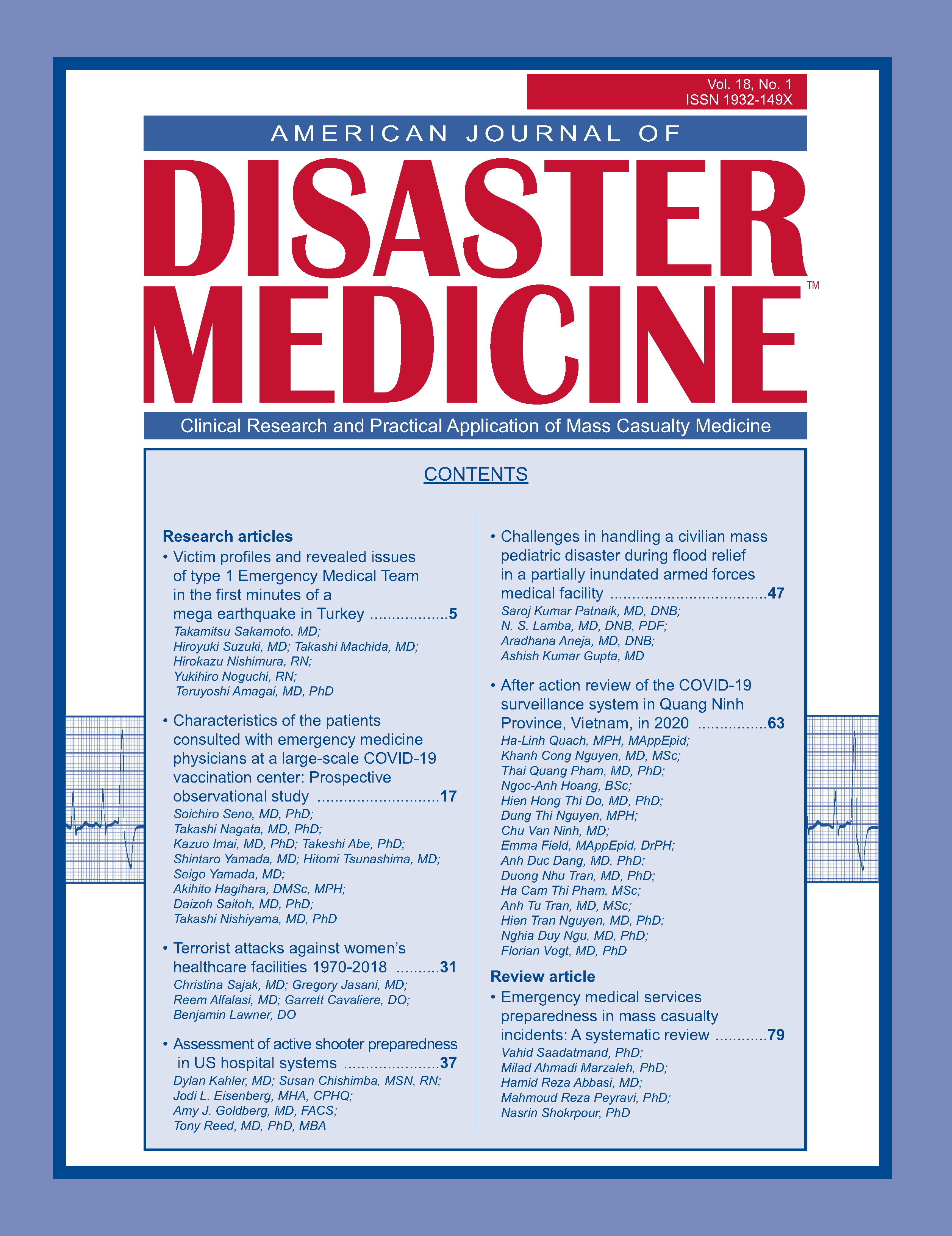Victim profiles and revealed issues of type 1 Emergency Medical Team in the first minutes of a mega earthquake in Turkey
DOI:
https://doi.org/10.5055/ajdm.0455Keywords:
disaster medicine, Emergency Medical Team (EMT), EMT Coordination Cell (EMTCC), Minimum Data Set (MDS), Tokushukai Medical Assistant Team (TMAT)Abstract
Background: On February 6, 2023, a series of mega-earthquakes (MEs) struck the southern parts of Turkey and northern Syria. In the first 16 days after the Turkey MEs (TMEs), the Tokushukai Medical Assistant Team (TMAT) backed by its infrastructure visited Turkey to support a local hospital. With the goal of helping local communities and working with local supporters and authorities, Turkey is on a mission to positively impact people’s lives.
Methods: Data collected covered the TMAT support period in February 2023. All patients admitted to a hospital were registered through the Minimum Data Set (MDS) of the Emergency Medical Team (EMT) Coordination Cell (EMTCC).
Results: A total of 561 patients were hospitalized during the 16-day mission. A review of the MDS data showed a decrease in the number of inpatients. The number of diseases directly related to the disaster was confirmed to be due to a gradual decrease in TME aftershock. However, the number of patients with nondisaster-related disease remained stable.
Conclusion: The experience of EMT in the initial relief of MEs that struck Turkey and Syria on February 6, 2023 showed that a mobile type 1 EMT in the early stage while rebuilding the infrastructure is essential. From the analysis of patient profiles, it is clear that knowledge and experience of skin diseases is needed in the first minutes of MEs. In addition, it has become clear that to ensure the quality of MDS for further analysis and to improve the efficiency and effectiveness of EMS, it is essential to have recorders in the EMS. These MDS recorders, called descriptors, must be isolated from the treating medical staff to eliminate subjectivity and ensure data accuracy.
References
Oba J: Report on activities in inpatient surgical emergency care by the Japan disaster relief medical team after the Nepal earthquake in 2015. Jpn J Disaster Med. 2020; 25(1): 48-53.
World Health Organization (WHO): Turkiye earthquake: External situation report no. 1. 2023: 13-19. Available at https://www.who.int/europe/publications/i/item/WHO-EURO-2023-7145-46911-68441. Accessed March 1, 2023.
World Health Organization (WHO): EMT global classified teams. Available at https://www.who.int/emergencies/partners/emergency-medical-teams/emt-global-classified-teams. Accessed March 1, 2023.
Ladeira LM: PT EMT—Portuguese Emergency Medical Team Type 1 Relief Mission in Mozambique. Cambridge University Press, 2021.
World Health Organization (WHO): Classification and Minimum Standards for Foreign Medical Teams in Sudden Onset. Geneva, Switzerland: WHO, 2013: 103.
Department of Disaster and Emergency Management: Ulusal Medikal Kurtarma Ekibi Birimi (UMKE). Available at https://acilafet.saglik.gov.tr/?_Dil=1. Accessed March 1, 2023.
Pennearu A: Do mobile hospital teams in residential aged care facilities increase health care efficiency: An evaluation of French residential care policy. Eur J Health Econ. 2022; 1-15. DOI: 10.1007/s10198-022-01522-1.
San H, Ozel M, Akkoc MF: First-week analysis after the Turkey earthquakes: Demographics and clinical outcomes of victims. Prehosp Disaster Med. 2023; 38: 294-300. DOI: 10.1017/S1049023X23000493.
Mavrouli M, Mavroulis S, Lekkas E, et al.: An emerging health crisis in Turkey and Syria after the earthquake disaster on 6 February 2023: Risk factors, prevention and management of infectious diseases. Healthcare. 2023; 11: 1022. DOI: 10.3390/healthcare11071022.
Nott S, Colbran R, Edwards M: Rural health workforce response to Australia’s recent natural disasters and emergencies, with a focus COVID-19. Rural Remote Health. 2023; 23(1): 8130. DOI: 10.22605/RRH8130.
Published
How to Cite
Issue
Section
License
Copyright 2007-2025, Weston Medical Publishing, LLC and American Journal of Disaster Medicine. All Rights Reserved.


